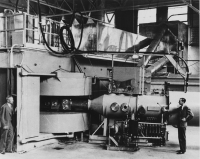








A cyclotron is a type of particle accelerator invented by Ernest O. Lawrence in 1932 in which charged particles accelerate outwards from the center along a spiral path.The particles are held to a spiral trajectory by a static magnetic field and accelerated by a rapidly varying (radio frequency) electric field.
In 1929, Dr. Ernest Lawrence came across a German scientific paper, written by R. Wideroe, that described "Kinetic voltage transformation". The apparatus used amounted to a glass tube with an ion source, a small tubular electrode connected to an oscillator, and a deflection plate. This small apparatus proved that RF fields could be used to accelerate particles. Until this time, this was done using a constant high voltage. Lawrence realized that to get acceleration matching that of the current high voltage machines the array of electrodes would be quite long. He theorized that a single electrode could be used if the ion beam was bent into a circular path using a magnetic field.
In 1930, a doctoral student began work on helping Lawrence prove his theory. Using a 4" magnet and a small vacuum chamber he began his work. The chamber was a thin brass ring capped on either end with disks sealed with red sealing wax. Inside the chamber was a hollow D shaped electrode, a slotted bar across the diameter, a filament, and a collector cup.
When hydrogen was introduced into the vacuum chamber, it was ionized by the electrons emitted by the hot filament. The voltage on the electrode accelerated these ions and as the energy became greater they spiraled outward and into a collector cup. This cup was attached to an electrometer, which measured the current induced by the ion beam striking it. This current was proof that Lawrence's theory was correct. Ions could be accelerated in a circular path.
The next year, a larger, 11 inch magnet was built. A new chamber and oscillator were also implemented. By 1932 protons were accelerated to over 1 million volts with this machine. This was the first time this had been accomplished in the history of physics. By this time Lawrence had already been working on construction of an even larger magnet. This became the 27-inch cyclotron.
By 1945 it was discovered that these machines were limited by relativity. This means that as the particle gains more energy it gains mass. Because the RF voltage across the electrodes is constant the effect of the kick is less on the more massive ions. This results in the ions being out of phase with the RF cycle; no more acceleration. A 184" cyclotron was in the process of being built. This was converted into a frequency modulated cyclotron. In this machine the RF frequency is decreased slightly as the orbit time of the relativistic particle changes, keeping it in synchronization. This was the end of the cyclotron era and the beginning of the syncro-cyclotrons and syncrotrons - the big machines of today.